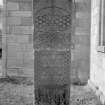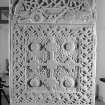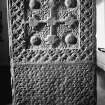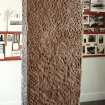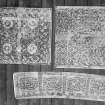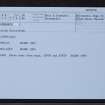Following the launch of trove.scot in February 2025 we are now planning the retiral of some of our webservices. Canmore will be switched off on 24th June 2025. Information about the closure can be found on the HES website: Retiral of HES web services | Historic Environment Scotland
Rosemarkie, Church Place, Rosemarkie Parish Church, Cross Slab
Cross Slab (Early Medieval), Pictish Symbol Stone (Pictish)
Site Name Rosemarkie, Church Place, Rosemarkie Parish Church, Cross Slab
Classification Cross Slab (Early Medieval), Pictish Symbol Stone (Pictish)
Alternative Name(s) Rosemarkie Churchyard, No. 1
Canmore ID 14393
Site Number NH75NW 7.01
NGR NH 7372 5763
Datum OSGB36 - NGR
Permalink http://canmore.org.uk/site/14393
- Council Highland
- Parish Rosemarkie
- Former Region Highland
- Former District Ross And Cromarty
- Former County Ross And Cromarty
Rosemarkie 1, Ross & Cromarty, Pictish cross-slab
Measurements: H 2.60m +, W 0.77m tapering to 0.71m, D 0.18m
Stone type: red sandstone
Place of discovery: NH 7372 5763
Present location: Groam House Museum, Rosemarkie (ROMGH.1992.1)
Evidence for discovery: found in two pieces in the floor of the old church prior to its demolition and the construction of a new church in 1821. Given the careful break between the two main panels on each face, it seems likely that the two halves had been re-used as gravestones at some earlier period, and the two square holes towards the base of face A may relate to that re-use. By the end of the nineteenth century, they had been concreted together and set upright in a metal cage outside the church. The slab was taken into Groam House Museum before it opened in 1980.
Present condition: very worn on all four surviving faces, as well as broken top and bottom. A small part of the top left corner of face A was been found separately.
Description
This very elaborately ornamented monument is carved in low relief on all four surviving faces, and it tapers slightly towards the base. Face A is edged with a double roll moulding and is divided by single roll mouldings into three panels. In the centre of what was originally a rectangular panel is a small square panel defined by roll moulding, which contains an equal-armed cross with squared terminals to the arms and open circular armpits. The cross is worn smooth but may originally have been decorated, and there are traces of a fine roll moulding outlining it. The sunken background to the cross bears key pattern, which extends into the armpits as spirals. Around the cross panel are four vertical rows of conjoined circular interlace with cruciform shapes between the rows. The middle panel contains an inner rectangle of zoomorphic interlace surrounded by a border of interlace. Only the top part of the third panel survives, with two circles flanked by lentoid forms, all four containing dense interlace work.
Face B is edged by a single roll moulding and is divided transversely by flatband mouldings into six rectangular panels of differing length. Each contains interlaced work of differing designs.
Face C is edged by double roll mouldings and is divided into three large panels by single roll mouldings. The top panel contains four huge Pictish symbols: three crescents and V-rods and one double disc and Z-rod, each with elaborate internal ornament, although most of the top crescent is missing. This internal ornament ranges from open zoomorphic interlace to dense key pattern, and the double disc is filled with seventeen spiral bosses. Between the top two crescent and V-rod symbols is carved zoomorphic interlace, but the background to the two lower symbols is plain. Instead a small double-sided comb is tucked in between the double disc and the lower arm of its Z-rod, and below the lowest crescent and V-rod are two motifs resembling Roman paterae. The middle square panel has key pattern forming a border round a central square panel containing an equal-armed cross. Again the cross is worn smooth but may originally have been ornamented. It has a square centre and stepped arm terminals, and there is raised boss between each of the terminals; both cross and bosses are surrounded by dense interlace. The third panel is full of key pattern.
Face D is edged by single roll moulding and is divided by flatband mouldings into three long panels: the top contains interlace, the middle contains zoomorphic interlace and th lower median-incised interlace.
Date: eighth or ninth century.
References: ECMS pt 3, 63-8; Henderson 1990, [1-3]; Henderson & Henderson 2004, 49-52; Seright & Henderson 2013, 6-7.
Desk-based information compiled by A Ritchie 2017.
NH75NW 7.01 7372 5763
No. 1. Class 2 cross-slab found in the floor of the old church before 1821, broken in two pieces but since fixed together. Until just prior to 1980 it stood outside the church close to the west porch but has since been moved to the Groam House Museum, Rosemarkie. The slab bears a complex design incorporating the double disc, crescent, Z- and V-rod symbols, and zoomorphic interlaced decoration.
J R Allen and J Anderson 1903; RCAHMS 1979.
Class II symbol stone.
(Undated) information in NMRS.
Field Visit (June 1979)
Rosemarkie, Carved Stones NH c. 737 576 NH75NW 7
The discovery of numerous 'Pictish' carved stones in the vicinity of Rosemarkie church indicates that this site was one of considerable importance during Early Christian times. Of the nine items described below (1) is in Groam House, High Street, Rosemarkie; (2) and (6)-(8) are in the tool-shed at Rosemarkie church; (3)-(5) are in the National Museum
of Antiquities of Scotland; and (9) is in Inverness Museum.
(1) * This Class II 'Pictish' cross-slab bears a complex design which incorporates double disc, crescent, Z- and V-rod symbols, and zoomorphic interlaced decoration; it was discovered within the former parish church before 1821.
RCAHMS 1979, visited June 1979
Allen and Anderson 1903, iii, 63-8, 85-8; Macdonald and Laing 1970, 137; Henderson
1971, 50-2.
Publication Account (1995)
This stone is some 2.6m high, and was found built into the floor of the old church. The top of the stone is missing, and probably part of the bottom too. One side is carved in shallow relief, with a small cross defined by sunk panels towards the top, the rest of the surface being covered with a variety of elaborate interlace. The other side, now turned to the wall, has four symbols at the top; three crescents and V-rods and one double disc and Zrod, all elaborately ornamented in contrasting styles. Above the lowest crescent is a comb and below it two mirrors, or perhaps one mirror and a mirror-case. The central panel on this side has an equal-armed cross of a type used in manuscript deco ration. The lowest panel is filled with key-pattern. Both edges of the slab are also decorated with elaborate interlaced ribbon patterns, some with animal heads.
Another dozen or so fragments of carved stones which may date to the 9th century AD are also kept in Groam House, some found in the churchyard. There are simple cross-slabs, a stone with treescroll ornament and two casts with parts of figures. Five other fragments with flat, all-over key patterns may all be part of a stone shrine that housed the relics of a saint or important cleric. Historical sources hint at a Christian establishment at Rosemarkie from the early 8th century, and the number of carved stones suggests a wealthy church or monastery flourishing in the later 8th and 9th centuries AD. Most probably illustrated manuscripts and metalwork were also produced here. The museum has information on other Pictish stones and a video on the Picts.
Information from ‘Exploring Scotland’s Heritage: The Highlands’, (1995).
Artefact Recovery (2007)
NH 737 576 The fragment is incised with a quadrant of an incised ringed cross. It is carved on one face only, Its condition is good and there is no differentiation in the colour of the sandstone between front and back. The surface background of the carved face is finely dressed. The surviving quadrant of the connecting ring is well proportioned in respect to the cross arms, and is accurately carved. The transverse arm meets the edge of the
slab which has no marginal moulding. The groove of the incision is comparatively broad (10mm) and may have been worked or rubbed to form a rounded profile after the initial cutting. There is a terminal circular hollow at the end of the groove of the external margin of the ring where it meets the surviving transverse arm and the lower, or upper, arm of the cross. This feature can also be seen where a vestige of another section of the ring has survived in this area. The groove which expresses this lower or upper arm has the same breadth as the groove used for the ring but it is cut slightly deeper. The surviving armpit of the crosshead is gently rounded. It is carved with a slightly broader (13mm) groove than that used for the ring. One edge is straight and dressed. It tapers slightly from 65mm to 72mm. The fracturing of the other edges of the fragment are rough, suggesting the breaking up of the slab for reuse as rubble. Secondary damage to the dressed edge is visible on the front face of the slab but two depressions on this edge adjacent to the back face may be part of the original
working of the edge. The bedding planes are clearly visible on the dressed edge and this internal structure of the slab accounts for the apparently natural smoothness of the back face. There is no evidence for the pebble inclusion which features on the back of ROMGH.1992.9.
The design of what survives of the cross is typical of Pictish and Ionan outlined ringed crosses. The straight edge suggests that the slab may have been regularly cut but straight edges and irregular top and bottom edges are also found. The meeting of the transverse arm with the edge of the slab and the lack of an edge
moulding is a usual feature. Such slabs are more usually carved with shafted, Latin, crosses, but equal-armed crosses, sometimes supported on a narrow shaft, are also found. The slight taper of the thickness of the slab and the deeper cutting of the surviving arm, which is not a transverse arm, suggests that the orientation
of the slab is probably what makes the straight edge the right side of the slab. The probability is that the arm which lies at the left of the fragment is the shaft. From the surviving design the width of the slab can be calculated. From the straight edge of the slab to the centre of the shaft is 173mm. At 346mm wide the slab is not large, but slabs of similar width are found in the collection on Iona and are common generally. If the slab bore a Latin cross then the height of the slab would probably have been around 750mm. The slab was probably funerary. It is difficult to tell whether slabs carved on one face only stood erect or were recumbent. Slabs can taper whatever their position. Only the fact that the depressions on the otherwise dressed straight edge were thought to be acceptable indicates that this slab lay on the ground where they would not be seen.
The fine dressing of the surface background of the front face, the confidence of the positioning of the ring, the conscious variation of the nature of the grooves, and the individual mannerism of the decorative circular hollows at the ends of the grooves, all suggest that this fragment is a remnant of a slab that easily takes its place in quality of design and execution with the rest of the exceptionally fine cross-marked funerary sculpture being produced in Rosemarkie in the Early Christian period.
I Henderson and I G Scott 2007



















































